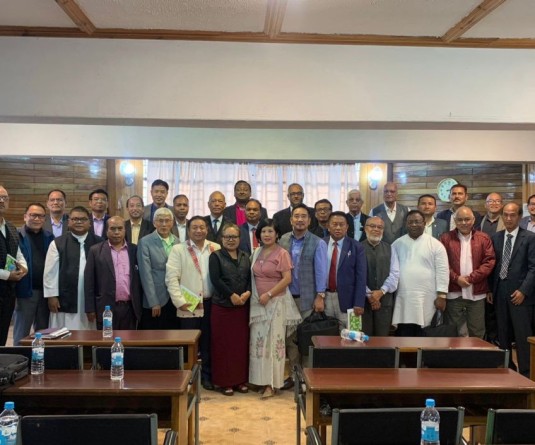
S Kumtsu Janger
Shamator town
It is a season when all millets are painted yellow. It is a solemn festival, when new ones are born and old ones are gone. Metümneo, festival of the Yimchungers, is traditionally celebrated for five days from August 4-8 every year. 'Me' means 'Soul', 'Tüm' means 'Ritualistic respect (wrapping)' and 'Neo' means 'Feast'. So the term literally means 'Soul Wrapping Festival'.
Kiulongpuh, as we call the festive announcer, would notify the ceremonial days. All five days have different names viz. Shito, Zhihto, Zumto, Khihresuk and Shiresuk. An elderly man known as Kheamphuru, inaugurates the event by uttering special prayers and initiates the rituals. Soon, like the birds spreading their colorful wings, the people dressed in colorful traditional attires leaps into their dances in various groups, both young and old.
If we could travel back to the former golden days, one would find splashing of rice beer on the right side of house, killing of domestic animals for food, cleaning of entire village and repairing of old roads, which marks the first day- Shito. It was followed by the cleaning of community roads and footpath leading to fields on the second day. On the third day, inter-village roads and bridges are repaired. Then comes the fourth day, whereon water points and springs in the vicinity of the villages are cleaned. People would gather in the Morung by sunset to celebrate through dancing and singing. On the fifth day, people spend the day by sharing rice, millet-bread, meat, rice-beer and other gifts. They would then sing solemn songs in honor of the departed souls and to welcome and rejoice at the birth of new souls.
It is also a season for the young folks to find their wife, and promise to yearn for a new life. Traditional gift for engagement called 'Muk-tak-lak' is presented to the fiancé. It is a season when people invite friends, visit relatives and exchanges gifts to strengthen ties and bonds of love. It’s a time when people thrill themselves, through various activities which includes the traditional top fighting, with an aim to rebuild mutual understanding and reconcile past mistakes. Primarily, it is also a celebration to welcome new born babies. Parents bless their offspring by preparing special lunch basket where pieces of meat are wrapped in banana leaves. For a male, there are six pieces of meat; and five for female, symbolizing the number of their souls. Then follows, ‘Kheangshukhe’ or sharing the lunch basket to all doors. The festival is also a celebration to bid farewell for those souls who are to die in the current and the coming year. It also marks an honor to the already departed souls. It’s a sweet sorrow, where people cheer and dance to bid the soul away. It’s a bitter joy, where people cheer to make the memories linger. They believe that the spirit of Metümneo will protect the one leaving and bless the one living.
In modern times, it has become a light celebration just to keep the tradition alive, to preserve the rich culture and to value one's identity. Gone are the celebrations where people practiced deep rituals and sacrifices when they would wake up early in the morning to invoke Supreme Being called 'Arim-buh.' With the advent of Christianity and civilization, people no longer practice old rites and all these have been replaced by celebration with gaiety, rich traditional extravaganza, prayer of thanksgiving, and seeking for blessings from God.




